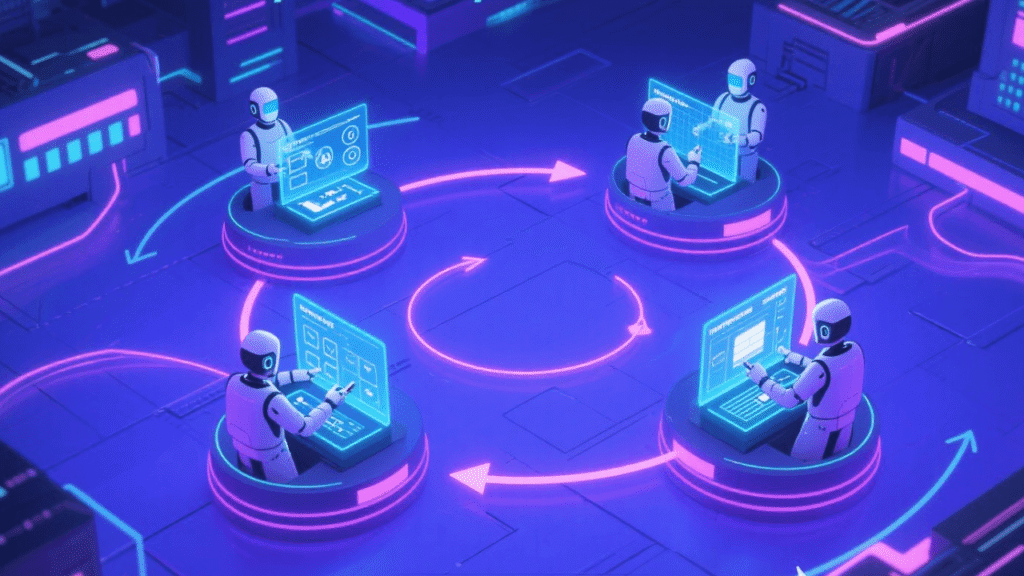Autonomous AI Agents: The Ultimate 2025 Guide to Automating Your Life & Business
Welcome to 2025, where Autonomous AI Agents are not just theory—they’re changing how life and business actually work.
Okay, picture this. You’ve got an assistant. Not a person in a suit, but some code living inside your laptop. You don’t have to explain every little thing—just toss it a goal: “Hey, find me the cheapest nonstop flight to New York for the holiday weekend. Oh, and don’t blow more than $500.” Then you wander off to make a snack, and by the time you’re back, it’s not just done—it’s crushed it. Price comparisons? Done. Airline reviews? Checked. Even drops a purchase link in your inbox so all you gotta do is click.
🎥 Original channel video IBM Technology
Sounds like a pipe dream, right? Nope. Welcome to 2025, where Autonomous AI Agents aren’t just some Silicon Valley fever dream—they’re already sliding into our daily grind. Where chatbots like ChatGPT let us chat with AI, these agents are actually doing stuff for us—handling the boring parts so we can, I dunno, actually breathe for a second.
Here’s the deal: this guide isn’t just tech jargon and buzzwords. I’ll break down what these agents actually are (without putting you to sleep), how they tick (building on ideas I also covered in Generative AI Beyond Basics: Practical Guide 2025 for Everyday Use), what tools are worth your time, and—most importantly—how to make them do your dirty work.
Work smarter, not harder, right? Let’s get into it.
Cracking the Code: So, What Are Autonomous AI Agents Anyway?
Alright, let’s break this down like we’re at a coffee shop, and you just asked, “What the heck is an Autonomous AI Agent?” So, picture this: it’s basically a software brain—think the guts behind ChatGPT, but with way more attitude. This thing looks around, figures out what’s up, makes choices, and actually does stuff… all with barely any hand-holding from a human. The whole point is, it’s not just sitting there twiddling its virtual thumbs, waiting for you to bark orders. It’s out here hustling, making its own plans, and getting things DONE.

Now, here’s where people get tripped up: “Isn’t that just a chatbot?” Uh, not really. Let’s call it what it is—a total glow-up. Here’s how they stack up:
| Feature | Regular Chatbot (like ChatGPT) | Autonomous AI Agent |
|---|---|---|
| Personality | Sits and waits for you to say something | Goes out and actually does stuff on its own |
| Job Description | Talks and churns out text | Solves problems, checks off to-do lists |
| Memory | Goldfish (forgets fast) | Elephant (remembers stuff from before) |
| World Access | Stuck in its own bubble | Can poke around the web, open files, use apps—wild |
| Example | “Write a blog post about AI.” | “Plan out my blog’s AI content for a whole month and post it.” |
So, how’s it thinking under the hood? Spoiler: there’s no Harry Potter magic here. What you’ve got is a smart loop that keeps running—taking in what’s happening, deciding what to do, actually doing it, and then repeating. Like a digital hamster wheel, but way more useful.
In short: Autonomous AI Agents are like the difference between a calculator and your super-resourceful friend who not only solves math problems, but also goes out, buys coffee, and sets up your calendar while she’s at it. Wild times, honestly. And just like tools such as OpenAI Sora: The Ultimate Guide to AI Video Generation are transforming creative work, agents are doing the same for productivity.
The Action Cycle: Plan, Do Stuff, Fix Your Mistakes

Alright, here’s how it really goes down:
- Planning: So you say, “Hey, help me plan my vacation,” and the AI’s first move is to huddle up with its inner brain (that’s just the LLM flexing). It chops up your big goal into bite-sized pieces. It’s basically thinking out loud: 1) Figure out where the heck you wanna go and how much cash you’re willing to burn. 2) Find flights that don’t cost an arm and a leg. 3) Hunt down hotels that aren’t nightmares. 4) Scrounge up stuff to do that won’t bore you to death. 5) Mash it all together into something resembling an itinerary. Classic checklist vibes.
- Execution: Next, the bot actually starts doing stuff. First thing on the list, it grabs whatever tool it needs—maybe it fires up a web browser, hits up some booking API, or pokes around your files. Whatever gets the job done.
- Self-Correct & Observation: After each move, it stops and checks, “Did that work, or did I just run into a brick wall?” Maybe the flight site’s down, or the hotel you liked is way out of budget. It doesn’t just shrug and give up. Nah, it tweaks the plan—maybe tries a new site, slaps on a price filter, or adds a totally new step it didn’t even think about before. This whole rinse-and-repeat thing keeps going until you actually get your vacation plans sorted.
The Revolution in Practice: 7 Ways AI Agents Will Totally Shake Up Your Routine
Alright, enough theory. Here’s where it gets spicy: let’s dive into some real-life scenarios where this tech flips your day-to-day on its head. Many of these agents rely on instant, on-device processing to function without lag, a capability powered by what’s known as Edge AI

So, picture this: you’re about to launch your own fancy online coffee shop, but you’re swamped, and honestly, who has time to stalk every competitor out there? You need the lowdown without spending your entire weekend glued to your laptop.
Here’s what this agent does. It basically turns into your nosy, over-caffeinated research buddy. First, it jumps onto Google, sniffs out the biggest names selling specialty coffee in the U.S.—we’re talking the top five big dogs. Then it pokes around their websites, checks out what’s hot (aka their three top-selling coffees), grabs their price tags, and peeps at customer reviews—the good, the bad, the “this coffee changed my life” and the “meh, it’s just beans.” Not just from their own site, either. This thing’s got FOMO. It scours Reddit and other third-party review spots, too. After all that, it slaps everything together in a neat little Markdown file, so you get the full picture without the headache.


Let’s be real: keeping your Twitter (sorry, X—still getting used to that) account poppin’ is a full-time gig. And if you’re doing it solo, just thinking about it is exhausting.
Here’s the fix: this agent turns into your own social media ghostwriter. It keeps an eye on the latest tech buzz from The Verge and TechCrunch—like, the top five stories every day.
Then it whips up two tweet drafts—one for the morning crowd, one for the afternoon zombies. Each tweet’s got an informative vibe, some cheeky engagement, and hashtags that actually make sense (no more #blessed on your coffee updates). All the drafts get stashed in a Google Doc, waiting for your final thumbs-up. Basically, you stay relevant, and nobody knows your secret weapon is a digital assistant, not a high-priced agency.

Let’s be honest: hunting for new clients makes you want to slam your head against the desk. It’s boring, and you’ve got better things to do.
What’s the agent’s job? “Hey, every day, check LinkedIn and Upwork for gigs with ‘WordPress Developer’, ‘SEO Specialist’, or ‘Content Strategy’ in the title. Only care about US or remote gigs. Grab the company name, project details, and the job link. Toss all that into the ‘Project Leads’ Google Sheet.” Simple.
How does it work? It does the grunt work—searches nonstop, weeds out the garbage, and keeps your spreadsheet looking neat. No more staring at endless listings. Just a fresh feed of gigs you might actually want.


Let’s face it, nobody’s got the time (or patience) to wade through endless financial reports.
Agent’s orders: “Keep an eye on Apple (AAPL) and Nvidia (NVDA). Every day, check for news that actually matters—like product launches, earnings calls, or some analyst making wild predictions. If something big drops, hit me up on Telegram with a quick 3-point summary.”
So yeah—you stay in the loop, barely lift a finger, and maybe even look like you know what you’re talking about at the next dinner party.

The struggle: You need a quick script to take care of some boring computer task, but coding? Not your thing.
Agent’s Mission: “Make me a Python script that keeps an eye on a folder—whenever a new .jpg or .png lands in there, compress it with Pillow and chuck the squished version into a ‘Compressed’ subfolder. Easy, right?”
How it goes down: The agent dives into the Pillow docs (so you don’t have to), spits out the whole Python script with comments so you know what’s what, and even tells you exactly how to install the stuff and run it. It’s like having a coding buddy who doesn’t get tired of your questions.


The hassle: Trying to get four friends together for dinner is, like, herding cats. Calendars, venues, bookings—honestly, who has the patience?
Agent’s Job: “Set up dinner for four next Friday night. Check my calendar and peek at [Friend 1] and [Friend 2]’s schedules—assuming they’re cool with you looking. Hunt down the best Italian spots downtown, see if they’ve got tables open, and hit me back with the top three options (links included, please).”
What it actually does: The agent hops between calendar apps, pokes around Google Maps for restaurants, digs through reservation sites, and lines up your best options so you can just pick and go eat. No awkward group texts required.

So, you wanna pick up Spanish but… honestly, you have no clue where to start. Yeah, we’ve all been there—staring at a mountain of apps and random YouTube playlists thinking, “Do I just memorize ‘hola’ and hope for the best?” Here’s the fix: imagine an agent that actually whips up a 30-day beginner plan for you. Like, mapped out by the day. Every single one has a theme (greetings, numbers, whatever), a free YouTube vid so you’re not just reading boring text, and a tiny 5-question quiz to see if anything stuck.
Basically, it does the heavy lifting—hunts down decent resources, lines up what to do each day, and throws in mini tests so you don’t just zone out halfway through. You just show up, do your 20 minutes, and hey—by the end of the month, you’re not totally clueless anymore.

How to Start Using Autonomous AI Agents TODAY: A Beginner’s Guide
No, you don’t need a computer science degree or some secret password to get rolling with this stuff. Honestly, the open-source crowd and a bunch of scrappy startups have made jumping into Autonomous AI Agents almost too easy.

What’s Hot in 2025?
- For total newbies: Web-based tools like AgentGPT and Godmode.space are your new best friends. You just type in what you want, sit back, and watch the magic happen right in your browser—no downloads, no headaches. It’s basically AI with training wheels.
- For tinkerers: Open-source projects like Auto-GPT are where it’s at. Yeah, you’ll have to roll up your sleeves and do some setup on your own laptop, but the power and flexibility are nuts. BabyAGI is another OG project, super stripped-down and all about just getting stuff done. Both are kinda legendary in the AI crowd, for good reason.
So, whether you just want to dip your toes in or go full mad scientist, there’s something out there for you. And hey, maybe you’ll finally stick with that Spanish plan this time.
Alright, let’s cut to the chase. CrewAI and LangChain? Yeah, they’re not these magic “push-a-button-and-you’ve-got-an-agent” tools. Think of them more like a box of LEGOs for developers—just a bunch of pieces and a vague picture on the front. You wanna build something cool? You gotta put in the elbow grease and snap it all together yourself. A TechCrunch article even said these frameworks are a must if you’re aiming for anything actually ready for primetime—so, not just a toy project.
Crafting Killer Objectives
This part matters way more than you think. If you’re vague, you get garbage out. Instead of “Go research electric cars”—what does that even mean?—try saying, “Make a side-by-side chart comparing Tesla Model 3, Hyundai Ioniq 5, and Ford Mustang Mach-E. I want range, price, and charging time. Hit me with the facts.” See the difference? Night and day.
Oh, and don’t forget to say how you want it delivered. Want a PDF? Spreadsheet? Email? Voice memo from Morgan Freeman? (Okay, maybe not that last one unless you know a guy.) Point is—spell it out.
Constraints? Throw those in too. “Don’t go over $5,000,” or “Stick to academic sources,” or “Don’t show me anything older than 2024.” Boundaries are your friend.
The Dark Side: What to Watch Out For
But hey, it ain’t all sunshine and rainbows. Let’s talk about the sketchy side. These agents—just like those chatbots that sometimes say bananas stuff—can hallucinate. Seriously, they might spit out info that’s totally made up. So, if it’s important, double-check. Always.
And security? Yikes. Giving some agent access to your email or files… risky business. Only stick with platforms you trust, and never hand out more permissions than you absolutely need. You wouldn’t give your house keys to a stranger, right? Same logic here.
Alright, let’s get real for a second—running these super-smart agents? Not cheap. Every little task they do racks up API calls, and those aren’t free. Unlimited access? Yeah, we’re not there yet. Maybe someday, but for now, you’ll feel it in your wallet.
The Future is Autonomous (And It’s Arriving Fast)
Anyway, let’s talk about what’s actually wild: the future’s basically gonna run itself. Autonomous AI agents are flipping the script on how we work with tech, from scheduling meetings to managing your smart home devices. (If you’re into that, check out Best Smart Light Bulbs 2025 – Top Picks & Buyer’s Guide for a glimpse of how everyday automation is evolving).
If you or your business get the hang of wrangling a whole pack of these specialized agents, you’ve basically unlocked god mode compared to everyone else stuck in the past.
Honestly, knowing how to boss these agents around—think less spreadsheet ninja, more AI conductor—is about to be as basic as knowing how to type. And when it comes to integrating everything, from apps to devices, it’s a bit like choosing the right hub for your smart home. (I even wrote about that in How to Choose a Smart Home Hub in 2025: Google vs. Amazon vs. Apple). Sleep on this, and you’ll get left behind.
Further Reading & Sources (For Geeks)
Wanna geek out even harder? I dug up some legit sources if you wanna take the plunge:
- Auto-GPT on GitHub: This is where the open-source magic happens.
- “Attention Is All You Need”: The OG Google paper that blew up the whole Transformer thing. No Transformers, no ChatGPT, no fun.
- LangChain Docs: If you’re itching to build your own agent army, this is the playbook.
Go nuts.
MIT Tech Review – AI Section: If you want smart, no-nonsense takes on what’s happening with AI right now, this is your spot.
FAQ Time
Is an Autonomous AI Agents gunning for my job?
A: Chill, it’s not coming for your paycheck—well, not exactly. What’s more likely is your job’s gonna shift. Those boring, click-click-copy-paste tasks? AI’s happy to gobble ’em up. That frees you up for the juicy stuff: big ideas, creative moves, real decision-making. Think less robot, more sidekick.
Do I need to be some code wizard to use this?
A: Nope, not at all. Most of these tools just want you to tell them what you want—in regular English, not Matrix-speak. As long as you can explain your goal, you’re golden.
Is it cool to use this with sensitive work stuff?
A: Eh, watch your step. Some platforms are safe for grandma’s secret recipes, others… not so much. If you’ve got private info, go with the fancy enterprise options or run things on your own turf. Don’t just trust any random tool with your work secrets.







